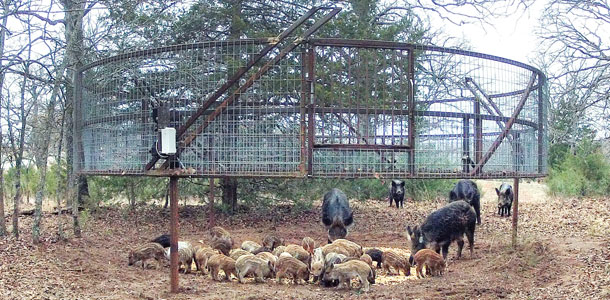Feral hogs are a source of misery for many land managers. They eat nearly anything and destroy valuable cropland, urban landscapes, and wildlife habitats and populations in the process. They also contaminate water supplies and spread disease to wildlife, livestock and humans.
The feral hog’s reproductive potential requires more than 70 percent of the population to be removed every year. One sow can have up to 15 piglets in one litter, and the average litter size is six.
Feral hogs can produce up to two litters per year, and female piglets are capable of breeding at 6 to 8 months old.
Because feral hogs are so prolific and populations are so widespread, landowners either already have a problem or will have one soon. The best time to start controlling feral hog numbers is the day the first one shows up.
Unfortunately, many landowners have already passed this point and population control now takes more effort. There is a diverse set of control strategies for feral hogs, some more effective than others, and each is best suited to particular areas or situations.
Hunting
Methods used to hunt feral hogs may be the most experimented of all techniques. Over centuries, hunters have manipulated their hunting practices to become more effective.
Some strategies for hunting feral hogs are incidental take, using night vision and thermal scopes, hunting with tracking and catch dogs, and following Judas hogs.
In general, hunting is one of the least effective techniques for controlling hogs at the population level but can be used effectively if populations are just emerging.
Feral hogs scatter quickly when fired upon or chased by hunting dogs, making it difficult to remove additional animals after the initial bout.
The Judas technique is implemented by affixing a radio collar to one hog and taking advantage of its gregarious behavior to locate other hogs in the area.
Snaring
In states where snaring is legal, state trappers often use the technique because it is cheap and easy. Snare lines can be run very quickly by pickup truck or ATV, so hundreds of snares may be placed along several miles of fencing.
Disadvantages to the technique include the fact that once a snare captures an animal, the snare is often damaged and unusable, and non-target animals can be captured and injured by snares.
Snare placement takes a lot of experience to minimize injuries to non-target animals. State laws often require snare lines to be checked at least once every 24 hours.
Aerial shooting
Aerial gunning can be fairly effective but should be implemented over large areas (a few thousand acres), requires a helicopter (expensive) and can be relatively dangerous considering the necessary low altitudes and slow speed.
Additionally, feral hogs may learn to avoid open areas when helicopters are present, hunkering down in dense vegetation.
Gunners may not be able to see through dense woody cover during the growing season or in areas with abundant evergreen trees, so this method may be restricted to winter months in areas with deciduous woodlands.
Aerial gunning works best when implemented on large cropland acreages where hogs have few places to hide.
Trapping
Trapping is probably the most effective feral hog control technique available to most land managers. However, trapping is an art; if not done properly, it provides opportunities for hogs to become educated to the dangers of traps.
Trappers should be strategic and disciplined so failures are minimal. Feral hogs are smart and will learn from failed attempts to trap them.
Some traps carry a higher risk of educating hogs than others. For example, box traps are often too small to contain an entire sounder of hogs, so hogs left outside the box traps when triggered witness the dangers of box traps.
Corral and box traps are often animal-activated, meaning the traps can accidentally capture non-target species or can be triggered after only a portion of a sounder has entered the trap. Several strategies can be used to mitigate some of these events, but few work every time.
A great deal of research has been invested in developing better traps that are remotely human-activated in order to allow the user to control trap deployment and eliminate non-target captures.
The electronics that allow remote observation and triggering are handy but do nothing to ensure hogs are comfortable entering the trap.
Therefore, research has also been done to develop traps that work to avoid trap shyness. Drop-nets (nets suspended in the air) avoid trap shyness but are not practical for most land managers.
Using drop-nets as the brainchild, The Samuel Roberts Noble Foundation developed the BoarBuster, a suspended corral trap.

The BoarBuster is completely suspended with no panels at ground level or door thresholds for hogs to cross, reducing trap shyness and making it possible to trap entire sounders remotely.
In addition to trap selection, several fundamentals should be considered when trapping. Bait placement is extremely important. A location where damage is observed is not always the best location to bait.
By placing bait near their daytime bedding areas, the bait is the first thing hogs encounter when they head out to feed, making them easier to pattern.
Always pre-bait a trap site. Pre-baiting means providing a consistent food source days before erecting a trap. Pre-bait for a minimum of three days and only provide enough bait for hogs to consume in 30 minutes.
When the quantity of bait is limited, all individuals in the sounder are forced to eat immediately or risk not getting anything. Later, when traps are set, there is a better chance of catching the entire sounder when the hogs are conditioned to hurry to the bait.
Infrared-triggered cameras are tremendous tools for trappers. They provide information to help select the appropriate control technique and trap size. If only one hog is using the bait, hunting may be the proper strategy.
Alternatively, if a large group is using the bait, a trap should be large enough to capture the entire sounder. Using several of these techniques in an integrated fashion offers the best opportunity to learn and will contribute to the success of future control efforts. ![]()
PHOTO: The BoarBuster feral trap combines overhead nets and corral systems. Photo courtesy of Noble Foundation.








